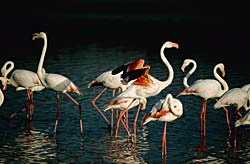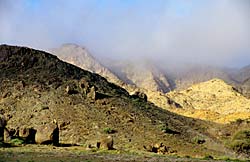| |
|
 |
|
South Africa - Namibia Transfrontier Region |
 As is the case with most transfrontier areas worldwide the greatest constraint to cross-country processes lies with relations at an international level. There is great potential for this region to function as one of the leading tourism destinations in the world. However, for this to happen the region must be planned in an integrated manner with government departments and other sectors of society from both countries working together for the good of the region and not only for their own countries. The inherent assumption is that a properly integrated transfrontier area should be worth more to both countries than two isolated parts that are separated by a colonial border and a lot of red tape. Through the years there have been various committees set up to accomplish the aim of an integrated region, including a Spatial Development Initiative (SDI); however, thus far the results of these committees and initiatives have fallen far short of achieving what they had set out to do. On the other hand, positive signs that transfrontier cooperation is on the rise are increasing. As is the case with most transfrontier areas worldwide the greatest constraint to cross-country processes lies with relations at an international level. There is great potential for this region to function as one of the leading tourism destinations in the world. However, for this to happen the region must be planned in an integrated manner with government departments and other sectors of society from both countries working together for the good of the region and not only for their own countries. The inherent assumption is that a properly integrated transfrontier area should be worth more to both countries than two isolated parts that are separated by a colonial border and a lot of red tape. Through the years there have been various committees set up to accomplish the aim of an integrated region, including a Spatial Development Initiative (SDI); however, thus far the results of these committees and initiatives have fallen far short of achieving what they had set out to do. On the other hand, positive signs that transfrontier cooperation is on the rise are increasing.
Planning the Transfrontier Picture
The transfrontier region potentially involves many sectors. Amongst them are conservation initiatives, tourism, mariculture, the Kudu gas fields, agriculture, and development of infrastructure such as roads.
With respect to the latter there are obvious linkages like opening a border post of Sendelingsdrift that will connect the Richtersveld to the main Luderitz - Keetmanshoop road via Rosh Pinah. There may be other border crossings in the pipeline for the Richtersveld/Ais-ais Transfrontier Park, as well as the option to cross the border and not having to use your passport as long as you stay within the Transfrontier Park. Another positive spin-off is that finally proper control can be exercised over usage of the Orange River for river-based tourism. There is also the possibility of opening the road from Alexander Bay to Luderitz via Oranjemund that will open up the coastal areas to both tourism and mariculture. The coastal road in the Sperrgebiet contains tremendous natural scenery as well as historical and abandoned mining towns.A transfrontier road system will also open up significant possibilities for mariculture and Orange River-based agriculture. Both Oranjemund and Alexander Bay have international standard airports. The latter has been declassified as an international airport but its status can be re-installed relatively easily. Oranjemund fortunately is still functioning as an international airport.
The Imperative
Essentially, transfrontier planning should view the region as an entity that can develop faster, in a more sustainable and more logically in terms of utilising its natural assets to relieve poverty. This should not be left to consultants. Instead, government as the elected body for governing the region, and accountable to the parties that will benefit by proper planning should take a far more prominent role. The Karas Regional Council on the one side and the Namakwa District Municipality and the Richtersveld Local Municipality on the other side, should develop a clear and practical planning framework that should be followed up by commonly agreed upon coordinators. All three parties have their own planning frameworks, the Integrated Development Plan (IDP) on the South African side and the Regional Development Plan (RDP) on the Namibian side. These planning frameworks are the ideal platforms from which to launch and implement transfrontier planning. Both sides are now also in possession of funding, of which the two GEF grants (one being the RCBCP GEF grant to the Richtersveld Local Municipality and the other the NACOMA GEF grant to the coastal Regional Councils - link to newsletter 3) are important ones in terms of integrated conservation and development. With funding and government planning frameworks in place there is less room for consultants and other types of "advisors", some of them little more than charlatans and opportunists, to manipulate the situation for their own benefit.
So, all is really in place. Like the old saying goes: "There is nothing to it but to do it". Perhaps the current initiatives discussed below can assist one another in leading the way.
Transfrontier Conservation Area
The Transfrontier Conservation Area (TFCA) is a proposed network of protected areas that includes the Orange River Mouth Transboundary Ramsar Site, the Richtersveld - Ai-Ais Transfrontier Park, the Richtersveld Community-based Conservancy and the Sperrgebiet.
 The Orange River Mouth Transfrontier Conservation Area (TFCA) process is underway and soon a Reference Group will be established to steer this process (see: (elsewhere) on this site). Other protected areas, or areas under some form of protective management on the South African side (see "Richtersveld - Unfolding the Big Picture") can be included in a growing overall Transfrontier Conservation Area that will consist of a national park, provincial parks, a community-based conservancy, several South African Heritage Resource Association (SAHRA) sites, municipal reserves and Sensitive Coastal Areas (SCAs). For more information contact local government at port@lantic.net and the Richtersveld Sida !Hub Community Property Association (CPA) at: floors@kingsley.co.za. On the Namibia side the picture is already far advanced, including the Sperrgebiet that will soon be proclaimed a protected area, the ORM TFCA, private areas under protective management and the Ais-ais reserve. For further information contact the Ministry for Environment and Tourism (nationally: biodiver@iafrica.com.na; and regionally: metkhp@iafrica.com.na) and the Karas Regional Council (karas@iafrica.com.na). Other organisations, including Conservation International are becoming involved in the wider Richtersveld TFCA. Contact details: hanksppt@iafrica.com. The Orange River Mouth Transfrontier Conservation Area (TFCA) process is underway and soon a Reference Group will be established to steer this process (see: (elsewhere) on this site). Other protected areas, or areas under some form of protective management on the South African side (see "Richtersveld - Unfolding the Big Picture") can be included in a growing overall Transfrontier Conservation Area that will consist of a national park, provincial parks, a community-based conservancy, several South African Heritage Resource Association (SAHRA) sites, municipal reserves and Sensitive Coastal Areas (SCAs). For more information contact local government at port@lantic.net and the Richtersveld Sida !Hub Community Property Association (CPA) at: floors@kingsley.co.za. On the Namibia side the picture is already far advanced, including the Sperrgebiet that will soon be proclaimed a protected area, the ORM TFCA, private areas under protective management and the Ais-ais reserve. For further information contact the Ministry for Environment and Tourism (nationally: biodiver@iafrica.com.na; and regionally: metkhp@iafrica.com.na) and the Karas Regional Council (karas@iafrica.com.na). Other organisations, including Conservation International are becoming involved in the wider Richtersveld TFCA. Contact details: hanksppt@iafrica.com.
Orange River Mouth Transfrontier Conservation Area (ORM TFCA)
In recognition of its exceptional ecological significance, the Orange River Mouth was designated a Wetland of International Importance in terms of the Ramsar Convention on Wetlands by both the South African and Namibian governments in 1991 and 1995 respectively. Not a statutory protected area at the time of its listing, the ORM has been managed on an ad-hoc basis by the diamond mining companies Alexkor Ltd. and NAMDEB, on the South African and Namibian sides of the border respectively. The general condition of the ORM TFCA has subsequently deteriorated, culminating in the collapse of the salt marsh ecosystem. As a result, the South African side was placed on the Montreux Record in September 1995, identifying the site as a priority for national and international conservation attention.

Flamingos of the Orange River Mouth Wetland and Ramsar Site
The ORM TFCA was on hold for a long time. The old Northern Cape Nature Conservation Service's director found it unacceptable that a provincial park could happen there unless the NCNCS owned the land. Furthermore, the ORM Interim Management Committee (ORMIMC) saw this grouping of mostly technical staff as the main steering mechanism. Finally, on the South African side where the blockages occurred, all three tiers of government, the Richtersveld communities and stakeholders get together to form a Reference Group to oversee the process.
Today the process is moving ahead with various stakeholders, including local government, provincial government, national government, Richtersveld community representatives, Alexkor Ltd and Namdeb, the Namibian government and expert advisers have been engaged in a variety of institutional and planning processes in order to address rehabilitation, development and management of the ORMTRS (see the DLIST ORMTRS case study).
On the South African side, the Richtersveld community have a lands claim pending for ownership of the Ramsar site. Following meetings with key stakeholders, progress has recently been made towards establishing a co-management agreement between the Directorate: Conservation and Environment in partnership with the Richtersveld community (see minutes from Port Nolloth meeting, March 2002).
For more information view the ORM development plan in the DLIST Library, follow process development in the DLIST ORM Discussion Forum, or contact: Floors Strauss (CPA), Joseph Cloete (Richtersveld Local Municipality), Abe Abrahams (NCNCS), John Dini (DEA&T) or Holber Kolberg (Namibian MET).
Richtersveld - Ai-Ais Transfrontier Park
 At first the Richtersveld/Ais-Ais Transfrontier Park ran the risk of becoming a play ball between different parties, including NGOs that were jostling for positions in leading this initiative. Fortunately, the relevant government departments as well as regional and local government tiers are taking an increasing lead to get this initiative on track and implemented as soon as possible. At first the Richtersveld/Ais-Ais Transfrontier Park ran the risk of becoming a play ball between different parties, including NGOs that were jostling for positions in leading this initiative. Fortunately, the relevant government departments as well as regional and local government tiers are taking an increasing lead to get this initiative on track and implemented as soon as possible.
DEA&T has set TFCAs as a priority development-planning framework, with a separate Chief Directorate created to drive the process from the national level. The Richtersveld/Ais-ais Transfrontier Park (TFP) is receiving immediate attention while other protected areas in the vicinity will be drawn into a larger TFCA over the years to come. Considerable funding has been made available for projects in the Richtersveld National Park through SANParks, and a trilateral agreement has been signed between DEA&T, SANParks and Peace parks Foundation (PPF) to implement the Transfrontier Park. The signing of the initial Memorandum of Understanding (MoU) that was facilitated by Eco-Africa is hailed as a major breakthrough as its set into motion the remainder of the transfrontier park (and later the broader TFCA) process. For more information visit http://www.peaceparks.org/ or contact the Coordinator Dr Peet van der Walt (PeetV@parks-sa.co.za).
|
|
|